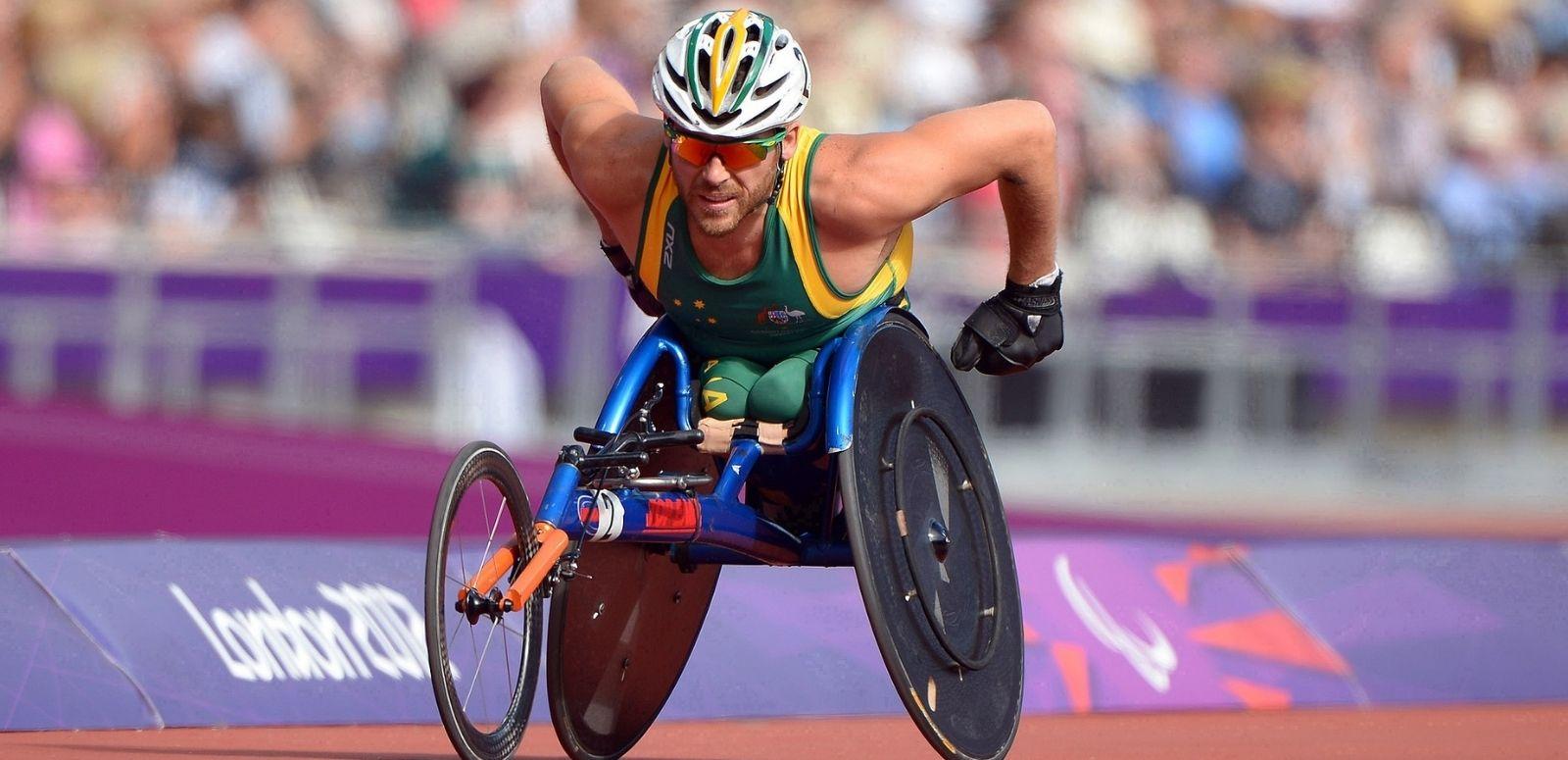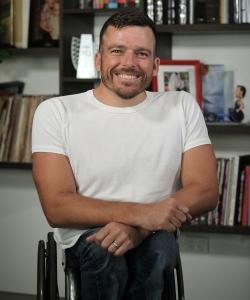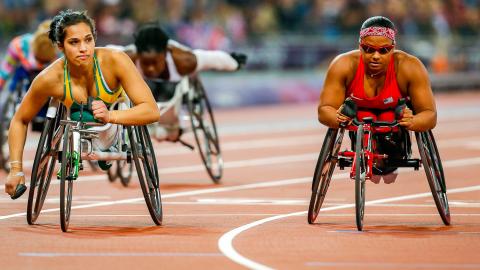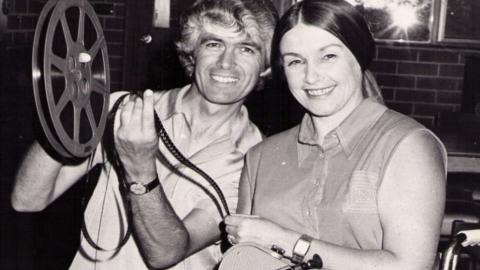

Kurt Fearnley
Paralympian Kurt Fearnley
To coincide with the Tokyo 2020 Paralympics and the NFSA's Australian Paralympians curated collection, we invited 3-time Paralympic gold medallist Kurt Fearnley AO to share his story.

A young boy's dreams
As a young boy I dreamed of wearing green and gold trunks and lining up in the pool alongside Kieren Perkins at the Olympics. He was a pretty good swimmer but I reckoned I went all right too. If not in the pool, I was pretty sure I was going to play first grade rugby league in the NRL. Maybe even for Australia if I got lucky.
Nobody from Carcoar, the town of about 300 where I grew up, told me I couldn’t, so I just figured I could. I hadn’t heard of the Paralympics, hadn’t seen a wheelchair race or a game of wheelchair tennis. Nobody had. Paralympic sport wasn’t on the TV, in the newspapers or in the consciousness of many Australians.
I was just like all the other kids. I wanted to play for Australia, win gold and maybe become rich and famous. The only sport I saw was the same as everyone else – able-bodied sport – so I figured that was for me too.
Out of reach?
Day one of high school in the big smoke of Blayney was probably the first day I was told I couldn’t though (over and over again by the harsh but true words of teenagers), and realised myself that maybe my dreams were a bit out of reach.
Jumping from a tiny primary school where most of the students were my brothers, sisters or cousins, I was smashed in the face with reality. Figuratively and literally, by a schoolbag or two swinging at my eye height as I negotiated the halls in my wheelchair.
As I waited to be carried up the stairs to my next class all I wanted to do was escape. Most of the students hadn’t seen a kid in a wheelchair before – heck, I hadn’t seen anyone else my age in a chair either – so the glares and stares were coming from all directions. I needed to get out and I figured the best way was up.
So I jumped out of my chair, crawled up the stairs, and yelled out for someone to hoist my chair behind me. It might not have been glamorous, and I needed some help, but it worked.
Raising the profile of Paralympic sport
Fast forward to the end of my wheelchair racing career in 2018. While I had picked up a few bruises, bumps and scrapes along the way, like that first day at high school, thankfully Paralympic sport was a lot better known.
Major Australian companies now feature Paralympic athletes in their advertising campaigns and as ambassadors for their products. Sport at the 2016 Paralympics was beamed on commercial television for the first time, then at the 2018 Gold Coast Commonwealth Games our events carried full medal status.
A cardboard cut-out of me in my race chair sat in the fruit and veg section of a supermarket chain alongside Australian Olympic gold medallist Sally Pearson. Children with a disability could see what was possible. Someone like them doing amazing things and being recognised for what they had achieved.
This year in the lead-up to the Tokyo Paralympics kids across Australia are trading stickers of their Olympic and Paralympic heroes. I even heard a boy who didn’t have a disability say when he grew up he wanted to be a wheelchair rugby player like his hero, Australian team captain Rylee Batt (see video below).
Visceral vision of wheelchair rugby games at the Beijing 2008 and London 2012 Paralympics is matched beautifully with this interview with Ryley Batt OAM. His responses exemplify why he is a great role model in addition to being one of the greatest wheelchair rugby players of all time. Excerpt from Weekend Sunrise, 20 February 2016. Courtesy Seven Network. NFSA:1484001.
Crawling the Kokoda Track
All this recognition isn’t just because of me but I’m proud to have played a part in raising the profile of Paralympic sport and people with a disability. I didn’t set out to crawl the Kokoda Track to get on TV. I wanted a holiday with my family and when it was proposed to take on the track, nobody told me that I couldn’t (well, they did, but I didn’t listen!) so I just figured I could:
This ABC News Canberra report profiles Kurt Fearnley's famous crawling of the Kokoda Track in 2009 and exemplifies the tenacity and perseverance that has made him a popular role model. The report effectively integrates footage from the Academy Award-winning Australian newsreel Kokoda - Front Line! to underscore the emotional tenor of Kurt's pilgrimage. Broadcast on 24 October 2009. NFSA: 1025308.
Proudest moment
One of my proudest moments racing for Australia was in the 2008 Paralympic Games in Beijing. While I’d finished on the podium a couple of times, I had some difficult races and hadn’t won the gold I’d set out for as I lined up in the final race of the Games, the marathon through the streets of the host city.
I was in with a chance with a few kilometres to go and as we raced into the famous Bird’s Nest stadium for the final 800 metres, I snatched the lead and didn’t let go. Gold. My second Paralympic marathon win after the gold I had achieved 4 years earlier in Athens:
This short clip includes footage of Kurt Fearnley's marathon gold medal win at the Beijing 2008 Paralympics. Typical of an end-of-bulletin sport’s round-up in its brevity, what it lacks in detail, it makes up for by packing in exciting footage of multiple gold medal wins and delivering the adrenaline boost viewers have come to associate with Olympic and Paralympic sports coverage. Excerpt from Seven News Adelaide, 17 September 2008. Courtesy Seven Network. NFSA: 765183.
London 2012
My win in 2008 set the scene for the next Games in London in 2012. I was going to shoot for something which few people had had the chance to attempt, let alone achieve: gold medals in the same event at 3 consecutive Games. I knew of someone who had got close. An Australian swimmer. A man with a face which was recognised by millions and the hero to thousands of young Aussies in the 1990s. A face well-known to me. My childhood idol, Kieren Perkins.
Unfortunately for Kieren it wasn’t to be, as he finished with silver at his final Games in his quest for 3 straight gold. I didn’t even get as close as Kieren with a bronze in London, but pushed on for one more time in Rio, my fifth and final Games. While I was pipped in the final 100 metres for gold, I finished with a silver to emulate my hero. Consecutive golds and a silver to round out our major Games careers. Maybe, after all, it was meant to be?
Kurt Fearnley AO is a 3-time Paralympic gold medallist and 2-time Commonwealth Games gold medallist. He has won over 40 marathons – including New York, Chicago and London – in a career spanning more than 20 years. In 2009 Kurt crawled the Kokoda track, in Papua New Guinea, to raise awareness of men’s health. Kurt was also a member of the winning Sydney to Hobart yacht crew, Investec Loyal, in 2012.
Relive – or discover – more thrilling sporting moments from 1994 to now in the Australian Paralympians curated collection.
Main image: Kurt Fearnley at the London 2012 Paralympics. Licensed under the Creative Commons Attribution-Share Alike 3.0 Unported license. Attribution: Australian Paralympic Committee.
The National Film and Sound Archive of Australia acknowledges Australia’s Aboriginal and Torres Strait Islander peoples as the Traditional Custodians of the land on which we work and live and gives respect to their Elders both past and present.


